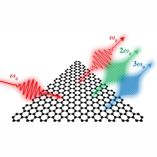2014/12/12
Nonlinear optical phenomena arise from the coupling between photons facilitated by their interaction with matter, and enable frequency conversion and all-optical switching effects. Unfortunately, the efficiencies of these processes are typically poor due to the low nonlinear response associated with conventional materials. Noble metal nanoparticles can help overcome this limitation on the nanoscale, as they enhance optical nonlinearities through strong electromagnetic field concentration provided by localized plasmons. Due to plasmonic enhancement, noble metal nanoparticles have demonstrated nonlinear frequency conversion with the highest recorded efficiencies per volume, and are generally regarded as the best available nonlinear nanomaterials.
In a recent study published in Nature Communications, Joel Cox and ICREA Professor at ICFO Javier García de Abajo (Nanophotonics Theory Group) have demonstrated that graphene nanoislands can host record-high levels of nonlinear response when they are electrically charged. This phenomenon is attributed to the strong light-matter coupling provided by graphene plasmons, which can be electrically tuned to yield nonlinear frequency conversion with efficiencies surpassing those of noble metal nanoparticles by several orders of magnitude. The results of their study predict that a relatively small amount of charge transferred to a graphene nanoisland can facilitate a dramatic increase in the magnitude of its nonlinear response, suggesting that graphene nanoislands can be used to develop nanometer-sized optoelectronic switches and modulators, or in the detection of minute amounts of analytes through their charge transfer to an island.
Link to paper
Link to research group led by Prof. Javier García de Abajo

Graphene plasmons vs noble metal nanoparticles
Graphene nanoislands shown to host record-high levels of nonlinear response when electrically charged.

Graphene plasmons vs noble metal nanoparticles













